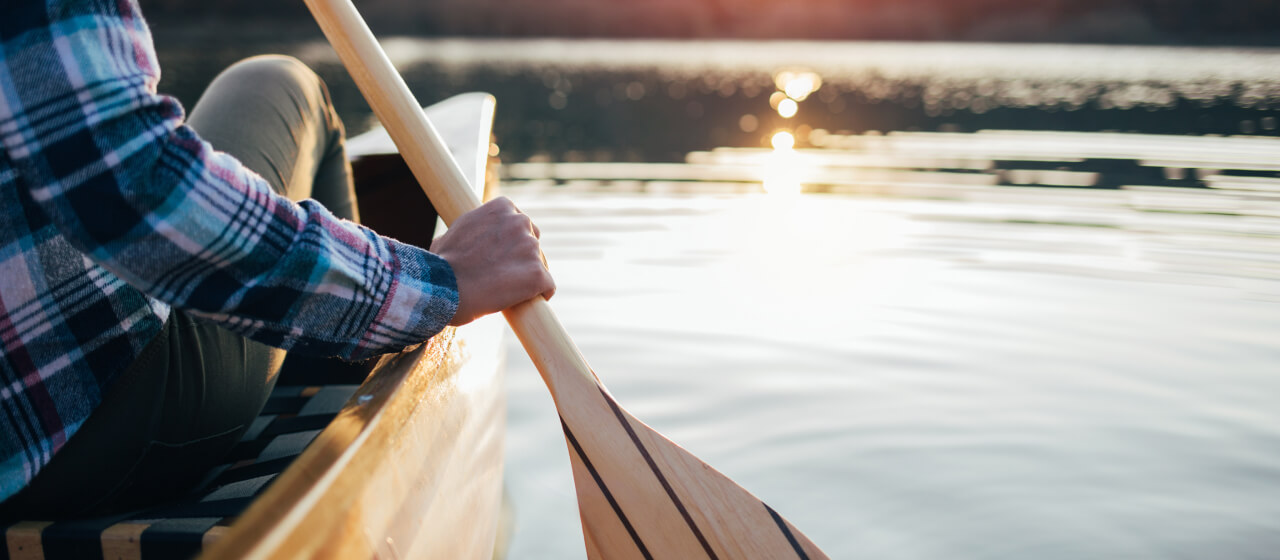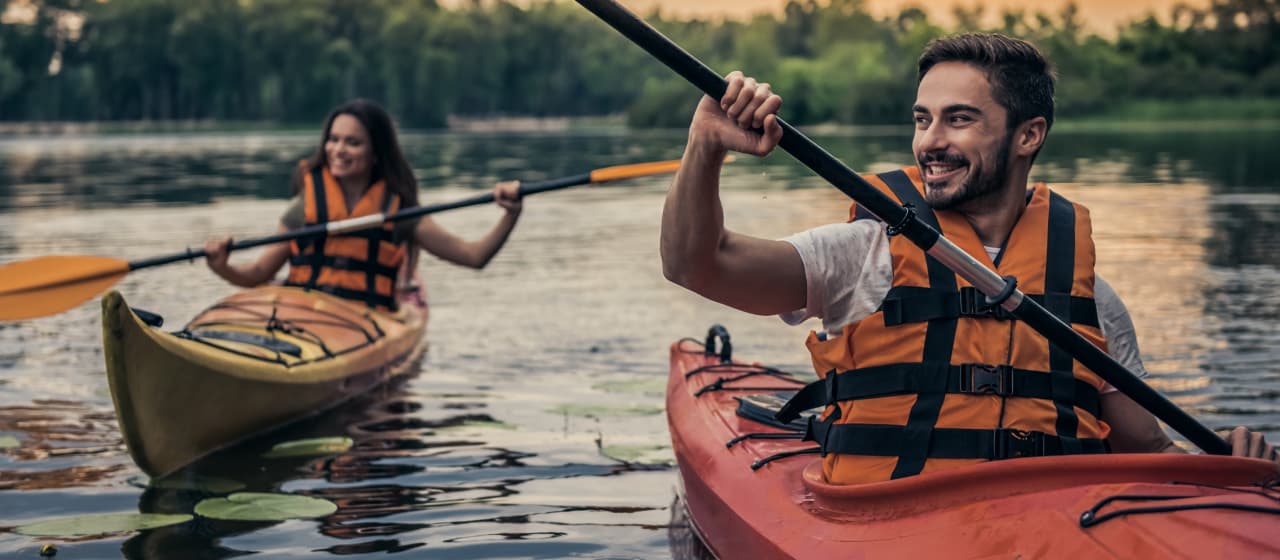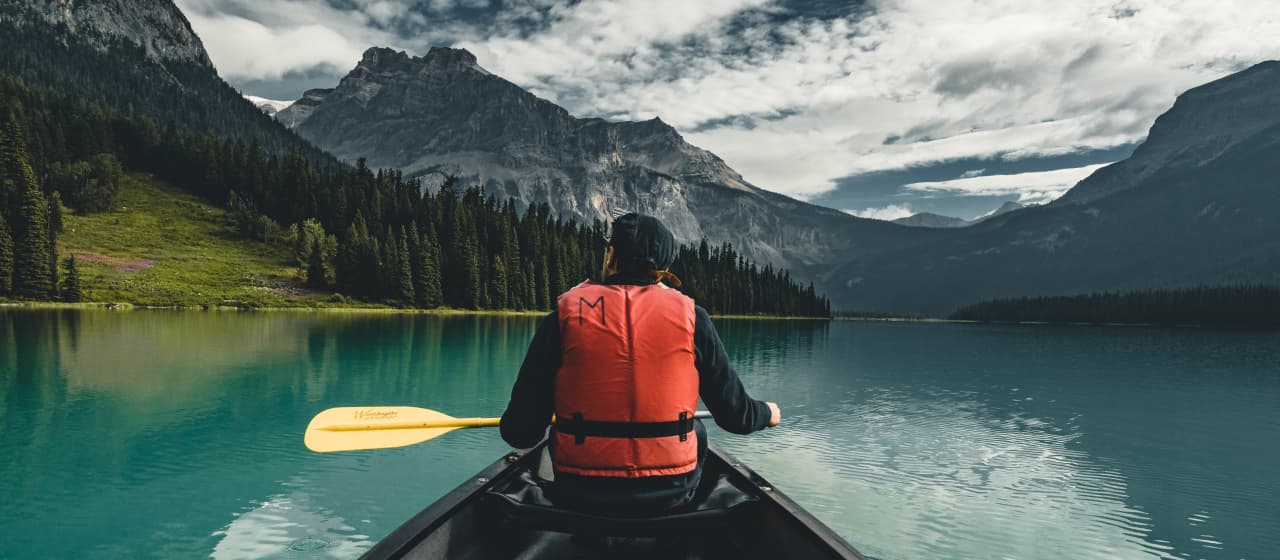Canoe vs Kayak 101: 6 Differences You Should Know

When it comes to recreational boating, there are two popular choices of vessels: canoes and kayaks. But what’s the real difference between them? Knowing the top six distinctions can prevent you from making the wrong choice! In this guide, you'll learn all about the differences between a canoe vs kayak and more!
6 Differences Between Kayaks & Canoes
Kayaks and canoes have six key differences. To help you make the best decision, we've also laid out the distinct pros and cons of both vessels. Use these links to help navigate the guide:
Expert Tip:
If you have a furry friend you want to bring along for the ride, a canoe offers more room than a kayak, allowing your pup to sit comfortably (don’t forget a doggy life vest!).
Comparing a Canoe vs Kayak
Bottom line: While visually similar, there are subtle and significant structural and technical differences between canoes and kayaks — including:
Kayaks: Carried by the cockpit on land; offer less stability on the water; require double-bladed paddles; often require less energy to paddle; seated row position with legs extended straight
Canoes: Carried by the yoke on land; give better stability on the water; require a single-bladed paddle; require more energy to paddle; seated row position (or kneeling) with legs bent
| Kayak vs Canoe Guide | ||
|---|---|---|
| Category | Kayak | Canoe |
| Paddle Type | Double-bladed paddle | Single-bladed paddle |
| Size | Varies from 6 to 19 feet long | Typically 16 to 17 feet long |
| Storage | Offers less storage space | Offers ample storage space for gear |
| Speed | Average about 3.5 miles per hour | Average about 3 miles per hour |
| People | One person unless a tandem kayak | Multiple people |
| Weight Capacity | About 250-300 pounds | About 940 pounds |
| Stability | Offers less stability in the water | Offers superior stability in the water due to the wider hull build |
| Learning Curve | Better for beginners | Better for more experienced paddlers |
Kayaking vs Canoeing
1: Different Paddle Sizes & Shapes

Single-Blade Paddles
A canoe uses a single-blade paddle.
These have one blade attached to a handle.
Grip both hands on it and paddle from one side of the boat to the other to propel forward.
They are shorter than a double-bladed paddle.
Double-Blade Paddles
A kayak uses a double-bladed paddle.
They have blades on each end and allow the paddler to alternate for a quicker pace.
They are longer than single-blade paddles.
They’re usually easier to learn and use than a single-blade paddle.
2: Different Paddling Techniques
Kayak Paddling Technique
Kayaks have a more lightweight vessel design and double-bladed paddles.
These unique paddles allow for easier water navigation.
The paddler simply grips the middle with both hands spread about two feet apart and then dips each blade into the water.
Alternate between paddling on each side of the kayak with each stroke.
Canoe Paddling Technique
Canoes typically weigh more than kayaks and require more effort to paddle through the water.
A canoe paddle usually has a T-shaped handle at the top with a blade at the bottom.
The paddler should place one hand on the handle and the other in the middle of the paddle and push down with both hands to move it along.
3: Boat Design

Canoes are bigger than kayaks: Their wide frames and open-deck designs can easily accommodate multiple people. You’ll have more freedom to move around in a canoe as well as more storage space for your gear or bulky equipment.
Kayaks often have a closed-deck design: Closed decks keep the top and inside of the vessel better protected from the water as you paddle. They also surround the paddler for better security.
Kayaks have one seating option: The paddler sits inside with their legs stretched out in front of them. You sit lower to the water in a kayak than you do in a canoe. Canoes have benches to sit on and slats to kneel on for a more adaptive paddling experience.
4: Weight Capacity
Kayaks: A typical weight limit for a standard kayak is 250-300 pounds. However, it can be more with a larger or tandem kayak. Keep the total weight of gear and passengers below 80% of the maximum weight capacity.
Canoes: Most canoes hold 2 passengers, measure 16 feet long, and can support up to 940 pounds. However, these numbers can vary depending on how the canoe is constructed (e.g. the materials, length, and width).
Expert Tip:
When it comes to weight capacity, kayaks are unique. A number of different types of kayaks exist, so this number varies wildly. A good rule of thumb for choosing a kayak is to estimate your weight plus the gear you’ll bring with you.
5: Getting Into the Boat
Kayak — from a dock: Keep the kayak parallel and stay low. Use the edge of the dock to steady yourself while lowering your body into the cockpit.
Kayak — from the shoreline: Position the kayak perpendicular to the shore with the cockpit at the edge of the water. Place your paddle behind you for support and use it to help maneuver yourself into the cockpit.
Canoe — from a dock: Position the canoe parallel to the dock. Step inside while staying low and steady yourself using the sides of the canoe or the dock.
Canoe — from the shoreline: Position the canoe perpendicular to the shore. Passenger two can stabilize the canoe while you walk slowly on the centerline of the canoe using the gunnels for support to get to your seat. Once settled in, passenger two should stay low and step into the canoe.
6: Water Type Flexibility
While canoes are practical and versatile, they’re best suited for non-competitive uses on calm flatwater. Recreational canoes are not suitable for whitewater. However, there are so many types of kayaks. You’ll find plenty of options well-suited for either flatwater and white water conditions — sometimes both!
Kayak Pros & Cons
Paddlers with an intentional destination will likely want a kayak. Their hulls have more efficient designs — which is great for you since you’ll exert less energy than you would in a canoe.

Kayak Pros
- Quick learning curve
- Faster and lighter design
- Easier to paddle
Versatile uses
Kayak Cons
- Less storage capacity
- Difficult to move around
- You usually get more wet
- Harder to get into
Canoe Pros & Cons
Many recreational paddlers and sightseers prefer canoes over kayaks! You sit higher on the water in them — meaning you’ll get to take in more of your surroundings. You’ll also benefit from more space to store any gear you bring along.

Canoe Pros
- More space for people, pets, and gear
- Stable design
- Better for longer trips
Easier to stay dry
Canoe Cons
- Heavier and difficult to transport
- Harder to maneuver and paddle
- Slower speed
- Not suitable for all uses
Have Fun Out There!
Now you know all about the differences between kayaks and canoes. Ready to choose your boat? Check out our guide that walks you through how to choose a kayak! You can also browse our selection of canoes and kayaks. Have fun out there!


